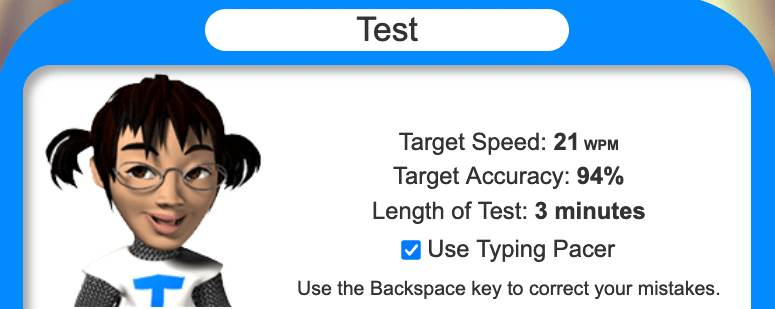Maths Invaders at Templeton Primary School
Aidan Schanssema, Director of Teaching – Numeracy, from Templeton Primary School gives insight into the use of Maths Invaders by Year 2 classes at the
The award-winning typing tutor, Typing Tournament now puts even more power in the hands of students and teachers.
In July 2021, EdAlive introduced the Pacer feature to Typing Tournament: a deceptively simple, yet revolutionary, innovation. The Pacer is a blue cursor that progresses across the text to be typed, at the target speed set for the test. When the user is ahead of the Pacer, the interval shows in green.

The Pacer mechanism visually informs the student of the target speed for the test – enabling them to continuously compare their speed to the target. This innovation is unlike anything offered by similar products. Now, after analysing students’ performance over many months, the effects of this change have become clear.

Touch-typing is most effective when the student no longer needs to look at the keyboard and typing becomes a function of muscle memory in the fingers rather than finger-eye co-ordination. However, this can be difficult to learn because the eyes are naturally drawn to where the fingers are active, and students can lack the confidence in their finger muscle memory to test themselves. The Pacer mechanism has the effect of drawing the eyes to the screen and several benefits flow from this.

Firstly, students made fewer errors, because they are reading the words to be typed in a smaller view frame – as compared to memorising a few words ahead so they can then look at the keyboard. Typically, keyboard errors were reduced by about 3%.
Secondly, errors made tended to be noticed more quickly which resulted in less use of the backspace key – a typical reduction of over 5%. This also resulted in a slight increase in the average number of correct characters typed.
Thirdly, the overall pass rate for timed tests increased. For early typing levels, the pass rate increased from 59% to 61%. For more advanced levels, the change was more dramatic, from an average of 44% to 64%. This appears to have happened partly as a result of the changes noted above – fewer errors and less use of the backspace key. However there seem to be additional factors contributing.
To pass a timed test, the student must meet a graduated speed threshold and independently meet a graduated accuracy threshold. After each test, their individual performance for speed and accuracy is shown along with the threshold values for that test – so that where a test has been failed the student can see whether their speed or their accuracy (or sometimes both) were the issue. We now suspect that students may often miss the implications of this information and continue to strive for speed even when accuracy is their issue. The Pacer mechanism supplements the end-of-test summary with continuous feedback on the student’s speed, before the test is completed. Further, the delivery of this information is visually compelling and readily digestible.
The overall implication is that the Pacer mechanism enables the student to self-manage the balance between speed and accuracy in their typing. We have shown that this is useful for navigating Typing Tournament, but we contend that it is also a useful component of touch-typing ability that they will take forward into the real world.
The benefits observed are smaller in the early levels where students are still learning the finger/key positions. However, after that point – beyond level 16 – the transition to automaticity of finger movement is made more natural, with resulting measurable gains in typing ability.
The greatest impact of improved pass rates was seen in the tests where most students experience the greatest difficulty – at one level we saw the pass rate increase from 14% to 36%. As a consequence, there were far fewer repeat tests required at this level. We also observed a greater number of tests being attempted (and passed) at the succeeding levels. This shows that students are not merely passing an abstract test, but demonstrably increasing in ability.
In the modern world typing is a vital skill for students throughout school and university, and indeed a skill for life. Typing Tournament is a powerful resource which schools can easily and successfully integrate into their daily program.
Aidan Schanssema, Director of Teaching – Numeracy, from Templeton Primary School gives insight into the use of Maths Invaders by Year 2 classes at the

The link between speed, confidence, fluency and attainment What does a confident student look like? Motivated – an enthusiastic learner who is ready to respond

Research demonstrates that the consistent use of Maths Invaders significantly boosts students’ answer speed (confidence) and attainment (maths age) at a rate well above normal